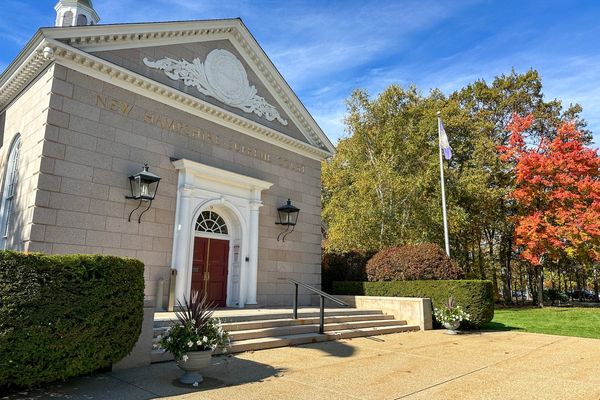
The conservative majority on the US supreme court appeared poised to weaken a key pillar of the Voting Rights Act after a lengthy oral argument on Wednesday, paving the way for a significant upheaval in American civil rights law.
After hearing arguments from lawyers for nearly two and a half hours, it seemed clear there was a majority on the court in favor of narrowing section two of the Voting Rights Act, which prohibits racially discriminatory electoral practices, as it applies to redistricting. The only remaining question in the case, Louisiana v Callais, appeared to be how far the court was willing to go.
A ruling narrowing section two would strip minority voters of a tool to challenge discrimination. For decades, voting rights lawyers have turned to section two to challenge district lines – from congressional districts to school boards – that dilute the influence of minority voters. Supreme court precent precedent requires plaintiffs to clear a series of challenging hurdles in order to strike down an existing district.
“This court’s cases in a variety of contexts have said that race-based remedies are permissible for a period of time. Sometimes for a long period of time, decades in some cases, but they should not be indefinite and should have an endpoint. What exactly do you think that endpoint should be?” asked Justice Brett Kavanaugh, a key swing vote in the case, to Janai Nelson, a lawyer for the NAACP Legal Defense and Education Fund, who was defending the maps.
Winning a section two lawsuit already requires plaintiffs to clear a series of high bars, Nelson said, including showing evidence of current discrimination. She added that maps are redrawn every 10 years. She warned the justices that a ruling weakening section two would be “pretty catastrophic”.
“We only have the diversity that we see across the south, for example, because of litigation that forced the creation of opportunity districts under the Voting Rights Act,” she said. “It is an intervention that that has been crucial to diversifying leadership and providing an ability of minority voters to have an equal opportunity to participate in the process.”
The court’s decision could also have immediate political consequences as Republicans plow ahead with an effort to redraw districts ahead of next year’s midterm elections. A decision getting rid of section two could cause Democrats to lose around a dozen seats in the US House, according to a New York Times analysis. Edward Greim, a lawyer representing white voters challenging Louisiana’s map, urged the justices to issue a ruling in time for next year’s midterms.
Cutting through the oral arguments, Justice Sonia Sotomayor summarized what those challenging the map were trying to do.
“The bottom line is get rid of section two,” said she said, towards the end of the argument, summarizing how she understood the plethora of arguments coming from lawyers attacking the maps.
The caseinvolves a dispute over Louisiana’s sixth congressional district, which snakes from Shreveport in the state’s north-west to Baton Rouge in the center. Louisiana Republicans drew the district after a successful lawsuit filed by Black voters under section two.
Those challenging the map, which included a group of white voters, the state of Louisiana, and the Trump administration – argued that the existing interpretation of section two essentially required lawmakers to rely too much on race when drawing district lines.
“Race based redistricting is fundamentally contrary to our constitution. It requires striking enough members of the majority race to sufficiently diminish their voting strength, and it requires drawing in enough members of a minority race to sufficiently augment their voting strength,” J Benjamin Aguiñaga, Louisiana’s solicitor general, told the justices.
Justice Neil Gorsuch, a conservative on the court, also seemed skeptical of the use of race in redistricting. “One argument is often ‘well once you’ve found a section two violation, you’ve got a compelling interest to go ahead and discriminate on the basis of race in your remedial map,” he said.
The court’s liberal justices tried to rebut those attacks by pointing out the court has long considered consideration of race under the right circumstances.
“Race is always a part of these decisions,” Justice Sonia Sotomayor said. “My colleagues are trying to tease it out in this intellectual way that doesn’t deal with the fact that race is used to help people.”
“What you’re saying to us [is] ‘if you use it to remedy past lingering discrimination, intentional discrimination, then you can’t use it,’’” she added.
Lawyers challenging the map said the court’s current interpretation of section two punished lawmakers for drawing district lines to achieve their desired partisan outcomes.
“If these were white Democrats, there’s no reason to think they would have a second district. None. And so what is happening here is their argument is because these Democrats happen to be black, they get a second district. If they were all white, we all agree they wouldn’t get a second district,” Hashim Mooppan, the principal deputy solicitor general, told the justices.
The justices already heard argument in the case in March, the supreme court took the unusual step of not issuing a ruling at the end of last term. Instead, it instructed the parties to address an explosive question: whether Louisiana’s decision to create an additional majority-minority district violated the 14th and 15th amendments to the constitution, which guarantee equal protection under the law and prohibit denying the right to vote based on someone’s race. In asking the question, the supreme court set up a blockbuster case on whether section two itself was constitutional when it comes to redistricting.
A ruling gutting section two could force the court to overturn precedent it issued just two years ago in a case in which it said Alabama had to add a second majority-Black congressional district. In that case, Allen v Milligan, the court upheld a decision requiring Alabama to draw a second majority-Black district under section two.
Chief Justice John Roberts, another key swing vote in the case, appeared searching for a way to distinguish Callais from the recent Milligan case. “That case of course took the existing precedent as a given and considered Alabama’s application of its approach to the evidence,” he said.
Nelson told Roberts Milligan was a “nearly identical case”. And at another point, Justice Elena Kagan, another liberal on the court, said those challenging the map in the case were rehashing the arguments the court had rejected in Milligan just two years ago. It seemed to be a clear play to get the attention of Roberts, who authored the majority opinion in Milligan and is likely aware of the institutional harm of gutting a precedent that isn’t even three years old.
“A couple of years ago when we decided Milligan, the party there, the state there, made several arguments that we specifically rejected. And in the answers that you just gave to me, it seems to me that you’ve repeated each and every one of those arguments that we rejected,” she said.
Kavanaugh seemed particularly interested in a proposal for the solicitor general’s office that would make it significantly harder for minority voters to challenge districts. Under the proposal, challengers would have to show that they could draw a reasonably configured district that gives them the opportunity to elect the candidate of their choice without sacrificing the political goals of the mapmaker.
Such a requirement would be virtually impossible to meet, Nicholas Stephanopolous, an election law scholar, wrote in a blogpost earlier this year.
“It would doom most section two claims in areas where most minority voters are Democrats and most white voters are Republicans. In these areas – which notably include much of the south – an additional minority-opportunity district can usually be drawn only at the cost of an existing Republican district,” he wrote in a post on Election Law Blog earlier this month. “This swap of an old Republican district for a new minority-opportunity district, however, is exactly what the SG’s proposal would prevent.”
The case is returning to the justices after a long and twisted legal saga.
After the 2020 census, Louisiana Republicans passed a congressional map in which Black voters only comprised a majority in one of the state’s six congressional districts. A group of Black voters sued under section two of the Voting Rights Act in March of 2022, arguing that it was possible to draw a reasonably configured district in the Baton Rouge area that would give Black voters a majority in a second-congressional district. A district court judge and US court of appeals for the fifth circuit agreed with them, ordering a new map. The supreme court let the map go into effect for the 2024 elections.
With the midterm elections fast approaching, Louisiana Republicans decided to draw a new map. Rejecting proposals from the plaintiffs, they adopted the strangely shaped Shreveport-to-Baton Rouge district for political reasons, saying they wanted to preserve the seats of powerful Republicans, including Mike Johnson, the House speaker, and Julia Letlow, a member of the appropriations committee.
The US supreme court has said there is nothing federal courts can do to stop redistricting for partisan advantage. A Black Democrat, Cleo Fields, won the new majority-Black congressional district last fall.
But when the new map went into effect, a group of white voters sued in a different court, saying that the new map violated the 14th and 15th amendments because it sorted voters based on their race. A three-judge panel agreed and struck down the new map and the supreme court heard the case on appeal.







